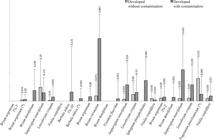Abstract
The use of micropropagation techniques is crucial for the conservation of endangered moss species and their reestablishment in nature. This study aimed to establish in vitro cultures of gametophyte fragments of ten species of Cerrado mosses. After disinfestation with alcohol and commercial bleach, moss explants were grown in Petri dishes containing Knop medium. The species Bryum argenteum, B. coronatum, Isopterygium tenerifolium, Leucobryum crispum, Pogonatum pensilvanicum, and Vitalia cuspidifera were successively established with efficiency rate ranging from 1 to 31.2%. However, no aseptic cultures were obtained for the species Barbula indica, Bryum densifolium, Fissidens flaccidus, and Sphagnum platyphylloides. Even though, a few contaminated explants of these species were able to develop and grow. Thus, all ten species were submitted to rescue techniques to establish cultures in aseptic conditions, from partially contaminated explants (indirect establishment). Consequently, the indirect establishment resulted in higher percentages of explant development, which enhanced the establishment of in vitro cultures for most of the species tested. This fact is especially important for conservation purposes, mainly for species whose material is sensitive or scarce. Therefore, indirect establishment as a new in vitro culture methodology was a viable form of propagating the bryophyte species listed in this research. This fact is essential for conservation purpose, especially for species whose material is sensitive or scarcer.
Key words:
bryophytes; conservation; cultivation; gametophyte; rescue

 Thumbnail
Thumbnail
 Thumbnail
Thumbnail
 Thumbnail
Thumbnail
 Thumbnail
Thumbnail



